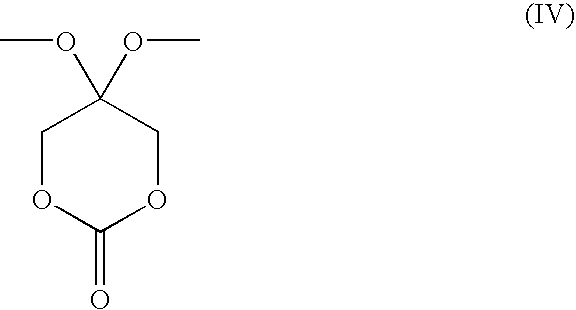Dihydroxyacetone-Based Polymers
a technology of dha and acetone, applied in the field of dha-based polymers, can solve problems such as the difficulty of polymerizing dha
- Summary
- Abstract
- Description
- Claims
- Application Information
AI Technical Summary
Benefits of technology
Problems solved by technology
Method used
Image
Examples
example 1
Synthesis of 2,2-dimethoxy-propane-1,3-diol (III)
[0025]2,2-dimethoxy-propane-1,3-diol (III) was synthesized according to the method of Ferroni, E. L., et al., J. Org. Chem., 64, 4943-4945 (1999). DHA dimer (25 g, 0.139 mole), trimethylorthoformate (30.4 ml, 0.278 mole) and p-toluenesulfonic acid (100 mg) were combined in 300 mL of methanol and stirred for 12 h. At this time 300 mg of Na2CO3 were added and the reaction mixture was stirred for an additional 12 h, after which the mixture was filtered and solvent was removed in vacuo. The resulting solid was recrystallized from ethyl ether to give 17.5 g of III (47%). 1H NMR (D2O) δ 3.58 (s; 4H), 3.24 (s; 6H). Anal. Calc.: C, 44.12; H, 8.82. Found: C, 44.50; H, 8.78.
example 2
Synthesis of 2,5-di-ethoxy-2,5-bis(hydroxymethyl)-[1-4]-dioxane (VII)
[0026]Synthesis of 2,5-diethoxy-2,5-bis(hydroxymethyl)-[1,4]-dioxane (VII) was carried out as follows: DHA (32 g, 177.8 mmole), triethylorthoformate (60 ml, 360 mmole), p-TsOH (128 mg) were combined in 300 mL of ethyl alcohol and stirred for 24 hours, after which time 400 mg of Na2CO3 were added and the reaction mixture was stirred for an additional 30 minutes and filtered. Removal of the solvent and residual triethylorthoformate in vacuo and recrystallization of the product from ethyl acetate resulted in title compound (31 g, 74%). 1H NMR (CDCl3) δ 1.14-1.24 (6H), 3.4-3.9 (12H). Anal Calc: C, 50.85; H, 8.47. Found: C, 50.89; H, 8.69.
example 3
Synthesis of 2,5-diisopropoxy-2,5-bis(hydroxymethyl)-[1,4]-dioxane (VII)
[0027]2,5-diisopropoxy-2,5-bis(hydroxymethyl)-[1,4]-dioxane was synthesized from DHA and triisopropylorthoformate in 2-propanol with p-TsOH as catalyst using the same protocol described in Example 2 for compound diethoxy derivative. 1H NMR (CDCl3) δ 1.18-1.26 (12H); 3.4-4.2 (10H). Anal. Calc. C, 54.53; H, 9.15. Found: C, 54.45; H, 9.06.
PUM
| Property | Measurement | Unit |
|---|---|---|
| Number average molecular weight | aaaaa | aaaaa |
| Molecular weight | aaaaa | aaaaa |
Abstract
Description
Claims
Application Information
 Login to View More
Login to View More - R&D
- Intellectual Property
- Life Sciences
- Materials
- Tech Scout
- Unparalleled Data Quality
- Higher Quality Content
- 60% Fewer Hallucinations
Browse by: Latest US Patents, China's latest patents, Technical Efficacy Thesaurus, Application Domain, Technology Topic, Popular Technical Reports.
© 2025 PatSnap. All rights reserved.Legal|Privacy policy|Modern Slavery Act Transparency Statement|Sitemap|About US| Contact US: help@patsnap.com



